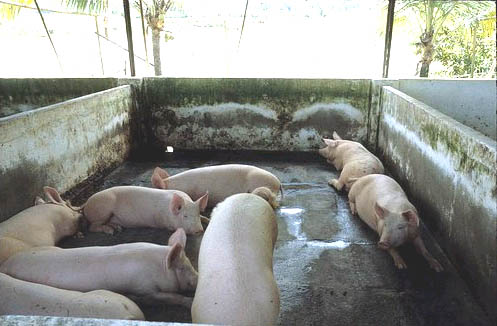|
Pig-Fish system
This system of integration is very common in China, Taiwan, Vietnam, Thailand, Malaysia
and Hungary. Pigs are fed largely on kitchen waste, aquatic plants and crop wastes.
The waste produced by 30-35 pigs is equivalent to 1 tonne of ammonium sulphate.
Exotic breeds such have White Yorkshire, Landrace and Hampshire are reared in pig-sty
near the fish pond. A floor space of 3-4 m2 is provided and boars, sows and finish
stocks are housed separately. Maize, groundnut, wheat-bran, fishmeal, mineral mixes
are provided as concentrate feed-mixture.
Depending on the size of the fishponds and their manure requirements, such a system
can either be built on the bund dividing two fishponds or on the dry-side of the
bund. Pigsties, however, may also be constructed in a nearby place where the urine
and dung of pigs are first allowed to the oxidation tanks (digestion chambers) of
biogas plants for the production of methane for household use. The liquid manure
(slurry) is then discharged into the fishponds through small ditches running through
pond bunds. Alternately, the pig manure may be heaped in localised places of fishponds
or may be applied in fishponds by dissolving in water.
Pigdung contains more than 70 per cent digestible feed for fish. The undigested
solids present in the pigdung also serve as direct food source to tilapia and common
carp. A density of 60-100 pigs has been found to be enough to fertilise a fish pond
of one hectare area. The optimum dose of pig manure per hectare has been estimated
as five tonnes for a culture period of one year. Such a quantity may be obtained
from 50 well-fed pigs. If the manure is to be applied in a dry form, a dosage of
400 kg/ha/day for 12 times in a year will be required. Fish like grass carp, silver
carp and common carp (1:2:1) are suitable for integration with pigs.

Pig-fish integrated system
Pigs attain slaughter maturity size (60-70 kg) within 6 months and give 6-12 piglets
in every litter. Their age at first maturity ranges from 6-8 months. Fish attains
marketable size in a year. Keeping in view the size attained, prevailing market
rate, demand of fish, partial harvesting of table-sized fish is done. Final harvesting
is done after 12 months of rearing. It is seen that a fish production of 3,000 kg/ha
could be achieved under a stocking density of 5,000 fish fingerlings/ha in a culture
period of six months. In India, through pigfish culture, the fish yield was doubled
compared to that of polyculture with intensive feeding.
Top
|